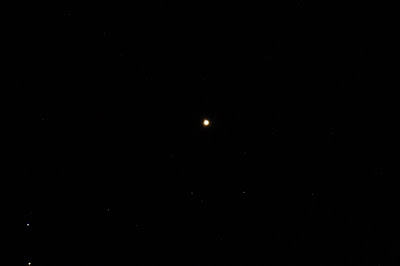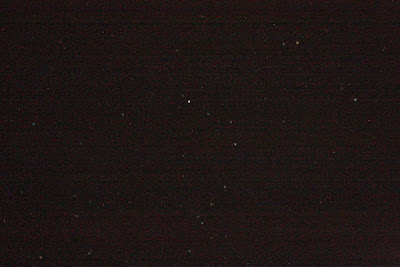8:43 PM, 10 July 2016. I've been ramping up to double star measurement notes practice.
Equuleus. "e-kul-lee-us." One of the original constellations by Ptolemy. One of the smallest. The ε (epsilon) star is a fast moving binary. A multi-star system! Chose 15 "reference" stars.
Considered only using the GBO Dell computer for focus control and my John Repeat Dance for mount and camera control. Prepared all the cabling. Considered closing the browser on the netbook to release memory. Continued powering up gear. Set the Optec focuser hand paddle to manual mode.
Somewhat attractive sunset. Lots of clouds. Was not feeling confident.
8:54 PM. Continued reviewing checklists. Reconsidered my target. Read some information about the WDS Neglected Doubles.
The lads returned from Collingwood. Had a quick chat. Collected CAO fees. Gave a tour of the THO.
9:36. Really cloudy. Seemed to be no wind. Could not see anything moving.
The ADDS showed the clouds were pushing off! The upper winds were moving. OK!
9:43. The lads said they were gonna split and come back if it cleared.
Fetched some juice.
Tried to find some candidate WDS neglected targets. Reviewed the three sets. Opened Set 3.
Considered HJ 1484 in Capricornus. It would be on the meridian at 2:15. And right at the 2 airmass. I wondered if I couldn't be able to see it, given I could not drop the south panels. Still, I added it ST3P neglected list.
Davis. As of 9:46. No wind, almost due north, very slightly east, humidity 71, pressure 1016.4, temp 17.7, dew point 12.4. Environment Canada, for Collingwood, from 7:00PM, said, pressure 101.6 and falling, dew point 13, humidity 52, tonight a few clouds, wind NNW, becoming light. Monday mix of sun and cloud, a high of 27, humidex 32, clear at night. Tuesday was to be clear too!
Found J2303. Added it in ST3P. Near Sagitta. High in the sky! Appeared to be a triple. First measurement was from 1895. Would pass the meridian at 2:00 AM.
10:13. Made my final decision... J2303! Cleared the observation status on the other candidates.
Add new candidate reference stars. Seemed to be a struggle this time. Did not enjoy it.
10:23. Checked the skies. It was getting better. Ian was having success at aligning.
10:32. Had 10 in the list. 5 more? Weird. It is in a busy part of the Milky Way but I couldn't seem to find many double stars...
10:38. Sky was slightly better. It was 21°C and 42% in the Warm Room accordingly to the Bionaire.
Reviewed the Moon set time: 12:30. That would give 1.5 hours of shooting time...
Looked for a focusing star.
11:00. Opened the roof. A pretty good sky. Much better. Very few clouds.
Closed all the browser windows on the little computer. Closed some of the additional Evernote windows. Fired up Firefox on the big laptop. Turned up the volume so to monitor the Facebook chat window. Started up Ananke. Bright! Connected to the Paramount with SkyTools via TheSky. Very interesting... The mount had been running the whole time, parked, after the solar observing, driven from the Dell. The resumption with the other computer went very smoothly. Closed the Interactive Atlas (blerg) to get the blinkie X cross pattern. Almost perfectly on target. Good pointing!
Did some visual stuff for a while...
1:36. Tarazed neared the meridian.
2:01. I turned on my camera and waited for EU to start up.
Mildly kicked myself for not going into town to get a modern USB-ethernet extender.
Closed EU and launched BYE. Took a long time. Camera was in manual mode from earlier in the day.
Started working on focus. Looked for a brighter star. Turned counter-clockwise. Headed to Vega. Still didn't see anything. Pointing was off a little. Did more crude focusing.
2:16. Automatic focusing on. FWHM down to 10.4. There's was a pointing bias, about 1 cm down, on my chart. 7 o'clock position. About 6.5 minutes as per SkyTools. Centred the star with the TheSky motion controls. Headed to Tarazed and then manually offset. Took a 5 second shot. Whoa. Way off. Off to the west so I slewed east. Then north. Did a sync in the TheSky. Did another 5 second shot. Realised I did not have the Live View on before whiling focusing. Rotated the field 180 in ST3P. Rotated some more. Good.
Set the ISO 1000 and initiated a 30 second shot.
Canon 40D, Celestron 14, f/11, Optec TCF-S, Backyard EOS.
Spotted a faint double near Tarazed, to the south: β55. Correction: a triple. A was down or south-west; B was above. C was well away to the west.
Tarazed itself is a double. It's very faint companion is down and right. SkyTools said it was magnitude 10.8 in the Object Information and 12.8 in the atlas.
Reviewed my notes. Oh Juliet Charlie. I totally forgot about squaring the camera... That is making the long edge parallel to the declination grid. Steps 6 and 7. Crikey.
Physically turned the camera. Used the grid in BYE using the number sign/pound button. It showed a medium-fine grid.
2:45. Started drift images. First shot it only went 1/4 of the way. In SkyTools, added a custom target for the starting point.
The sky would soon get bright. I realised I had mistimed this. I should have started about 1 hour before the targets reached the meridian.
First full trail came in. It looked very good. Only slightly off.
Optimised my process:
- wait for the shutter to close
- turn tracking on (in TheSky)
- slew to starting point (in SkyTools)
- turn tracking off (TS6)
- start imaging (in Backyard EOS)
Murray visited me. Curious what I was up to. He was evaluating a mount for KW. It had not gone well, unfortunately. Let me know they were headed back to the hotel. Cheers!
Wondered if I was losing the sky. It was super-bright to the south-east.
Programmed a run with a 20 second pause. Considered that at 2 seconds or 1 second from the end of the gap. Tried it. The gap was too long, given the download time...
3:12. The lads headed down the drive.
There seemed to be high cirrus cloud...
Dropped the ST3P list updating frequency from 2 to 5 minutes.
I had 7 trails so far. Half-way. Dropped the gap to 5 seconds. It worked. Didn't have to rush and didn't have to wait very long.
Had enough time during a trail image to run to the kitchen. Midnight—er, 3 AM—munchies.
Six to go.
Considered shooting the target first and the calibration stars later. Given I was losing the sky.
It was almost 3:30. And astronomical twilight would be beginning. Oops...
I wondered by BYE was using RAW + JPEG large for imaging. And why could I not seem to change this...
3:38. Drift imaging run was done.
Slewed to J2303. Started to image. Good! I was on target.
Canon 40D... Stretched slightly in DPP. J2303 is bright star above centre. B visible zoomed out; C visible zoomed in.
3:41. Tried a 60 second shot. Changed the name. Started exposing.
The TCF was making small adjustments. The air temp was higher. The wind had shifted.
Checked the image. Foxtrot. Nothing. Clouds?! Looked outside... Damnit! Frickin' clouds. Pulled up the weather radar. It was huge. I realised I was not going to get a break.
Set to 120 seconds on the off chance... Damn. Nothing. Nothing in the image. Checked the sky. No point!
Parked the 'scope. Closed the roof. Capped the C14. Turned off the focuser (3784) and dew heating system. Shut down the focuser app. Slept the laptop. Closed TheSky.
3:48. Programmed a darks run at ISO 1000. Copied the BYE log to a Notepad for review. For 120 seconds, 60, 30, 3, 2, and 1. Go! BYE showed it finishing in 1.5 hours. Left the ASUS.
3:59. Grabbed the Android and recorder. The sky was gone. Bright to the north-east. Returned to the house.




No comments:
Post a Comment